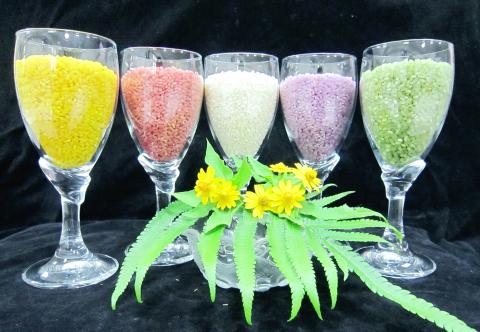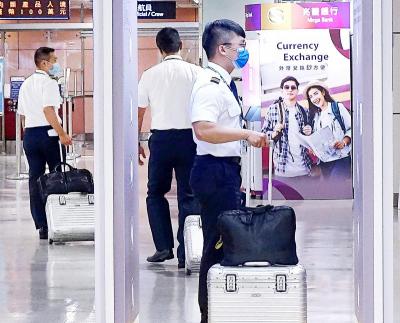The Hualien District Agricultural Research and Extension Station said it hopes that adding color to rice can help restore the staple to its former popularity in Taiwan.
Although first created at a Hualien County research center a few years ago, center officials said that the colorized rice could then only be produced in limited quantities, which could not meet demand as the technology to produce it was still under development.
Now, the processing technology has been improved, the officials said.

Photo: You Tai-lang, Taipei Times
It is now possible to produce 2 tonnes a day, and plans are underway for mass production, they said.
“It took us seven years of research and development to come up with the technology to color the rice. Our objectives were to raise the consumption of our nation’s home-grown rice, rectify Taiwanese consumers’ changing choices of staple food and entice children to eat rice and for people to have fun when enjoying their bowl of rice,” said Chiu Shu-yuan (邱淑媛), one of the researchers who worked on the colorized rice project at the Crop Improvement Section of Hualien District Agricultural Research and Extension Station under the Council of Agriculture.
“We utilized the natural dyes from fruits and vegetables to produce the yellow, red, green, lavender and other kinds of colorized rice,” she added.
“We were granted a patent on this technology for ‘color coating of rice.’ It will be transferred to the private sector for mass production of 2 tonnes a day, through an exclusive licensing arrangement,” she said.
The dyes for the rice come from natural ingredients, with Monascus anka, or red yeast rice used for red colorized rice, turmeric for yellow, leafy vegetables for green and the antioxidant plant pigment anthocyanidin for lavender.
The researchers said colorized rice could be marketed for daily meals at home, and for creative culinary uses in rice dishes at restaurants, private lodgings and leisure resorts.
They said it could also be developed for special organic or vegetarian menus and as a tourist attraction for Hualien County.

Three Taiwanese airlines have prohibited passengers from packing Bluetooth earbuds and their charger cases in checked luggage. EVA Air and Uni Air said that Bluetooth earbuds and charger cases are categorized as portable electronic devices, which should be switched off if they are placed in checked luggage based on international aviation safety regulations. They must not be in standby or sleep mode. However, as charging would continue when earbuds are placed in the charger cases, which would contravene international aviation regulations, their cases must be carried as hand luggage, they said. Tigerair Taiwan said that earbud charger cases are equipped

Foreign travelers entering Taiwan on a short layover via Taiwan Taoyuan International Airport are receiving NT$600 gift vouchers from yesterday, the Tourism Administration said, adding that it hopes the incentive would boost tourism consumption at the airport. The program, which allows travelers holding non-Taiwan passports who enter the country during a layover of up to 24 hours to claim a voucher, aims to promote attractions at the airport, the agency said in a statement on Friday. To participate, travelers must sign up on the campaign Web site, the agency said. They can then present their passport and boarding pass for their connecting international

WEATHER Typhoon forming: CWA A tropical depression is expected to form into a typhoon as early as today, the Central Weather Administration (CWA) said yesterday, adding that the storm’s path remains uncertain. Before the weekend, it would move toward the Philippines, the agency said. Some time around Monday next week, it might reach a turning point, either veering north toward waters east of Taiwan or continuing westward across the Philippines, the CWA said. Meanwhile, the eye of Typhoon Kalmaegi was 1,310km south-southeast of Oluanpi (鵝鑾鼻), Taiwan’s southernmost point, as of 2am yesterday, it said. The storm is forecast to move through central

The age requirement for commercial pilots and airline transport pilots is to be lowered by two years, to 18 and 21 years respectively, to expand the pool of pilots in accordance with international standards, the Ministry of Transportation and Communications announced today. The changes are part of amendments to articles 93, 119 and 121 of the Regulations Governing Licenses and Ratings for Airmen (航空人員檢定給證管理規則). The amendments take into account age requirements for aviation personnel certification in the Convention on International Civil Aviation and EU’s aviation safety regulations, as well as the practical needs of managing aviation personnel licensing, the ministry said. The ministry